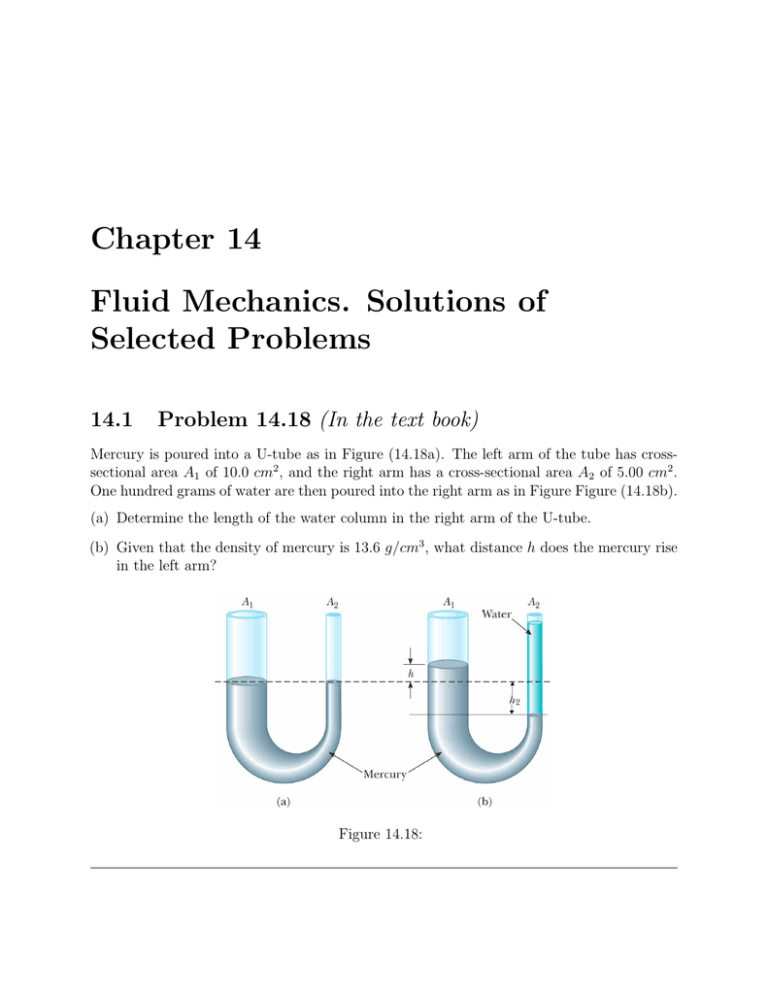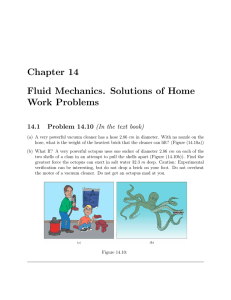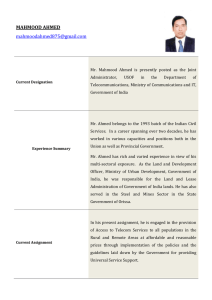Chapter 14 Fluid Mechanics. Solutions of Selected Problems
advertisement

Chapter 14 Fluid Mechanics. Solutions of Selected Problems 14.1 Problem 14.18 (In the text book) Mercury is poured into a U-tube as in Figure (14.18a). The left arm of the tube has crosssectional area A1 of 10.0 cm2 , and the right arm has a cross-sectional area A2 of 5.00 cm2 . One hundred grams of water are then poured into the right arm as in Figure Figure (14.18b). (a) Determine the length of the water column in the right arm of the U-tube. (b) Given that the density of mercury is 13.6 g/cm3 , what distance h does the mercury rise in the left arm? Figure 14.18: 2 CHAPTER 14. FLUID MECHANICS. SOLUTIONS OF SELECTED PROBLEMS Solution (a) The volume of the water in the right arm is: Vw = = = = hw = = = mw ρw 100 (g) 1.00 (g/cm3 ) 100 cm3 hw A2 Vw A2 100 (cm3 ) 5 cm2 20 cm (b) Figure (14.18b) represents the situation after the water is added. A volume A2 h2 of mercury has been displaced by water in the right tube. The additional volume of mercury now in the left tube is A1 h. Since the total volume of mercury has not changed, then A2 h2 = A1 h or h2 = A1 h A2 (14.1) At the level of the mercurywater interface in the right tube, we may write the absolute pressure Pr as: Pr = P◦ + ρw ghw The pressure P` at this same level in the left tube is given by: P` = P◦ + ρHg g(h + h2 ) Since P` = Pr we get: P◦ + ρHg g(h + h2 ) = P◦ + ρw ghw (14.2) Substituting for h2 from Equation (14.1) into Equation (14.2) we get: Physics 111:Introductory Physics II, Chapter 14 Winter 2005 Ahmed H. Hussein 14.1. PROBLEM 14.18 (IN THE TEXT BOOK) 3 ρw ghw = ρHg g(h + h2 ) A1 = ρHg g h + h A2 A1 = ρHg gh 1 + A2 We then find h as: ρw hw ρHg (1 + A1 /A2 ) 1.00 (g/cm3 ) × 20.0 (cm) = 13.6 (g/cm3 ) × (1 + 10.0/5.00) = 0.490 cm h = Physics 111:Introductory Physics II, Chapter 14 Winter 2005 Ahmed H. Hussein 4 CHAPTER 14. FLUID MECHANICS. SOLUTIONS OF SELECTED PROBLEMS 14.2 Problem 14.26 (In the text book) The weight of a rectangular block of low-density material is 15.0 N . With a thin string, the center of the horizontal bottom face of the block is tied to the bottom of a beaker partly filled with water. When 25.0% of the blocks volume is submerged, the tension in the string is 10.0 N . (a) Sketch a free-body diagram for the block, showing all forces acting on it. (b) Find the buoyant force on the block. (c) Oil of density 800 kg/m3 is now steadily added to the beaker, forming a layer above the water and surrounding the block. The oil exerts forces on each of the four side walls of the block that the oil touches. What are the directions of these forces? (d) What happens to the string tension as the oil is added? Explain how the oil has this effect on the string tension. (e) The string breaks when its tension reaches 60.0 N. At this moment, 25.0% of the blocks volume is still below the water line; what additional fraction of the blocks volume is below the top surface of the oil? (f) After the string breaks, the block comes to a new equilibrium position in the beaker. It is now in contact only with the oil. What fraction of the blocks volume is submerged? B T mg (b) (a) Figure 14.19: Physics 111:Introductory Physics II, Chapter 14 Winter 2005 Ahmed H. Hussein 14.2. PROBLEM 14.26 (IN THE TEXT BOOK) 5 Solution (a) The free body diagram for the block showing all forces acting on it is shown in Figure (14.19a) (b) Since the body is at rest then the sum of all forces must be zero, i.e. B − mg − T = 0 or B = mg + T = 15 + 10 = 25 N (c) Since the block is not submerged, the oil will then push inward on each side of the block. Tis situation is shown inFigure (14.19b) (d) The tension in the string increases as the oil is added. This is because the oil increases the pressure on the water surface and the buoyant force on the block increases. (e) The situation just before the string breaks is shown in Figure (14.20a), where the forces are mg = 15 N as before, the tension T = 60 N , the buoyant force due to water Bw = 25 N since the block is still only 25% under the water, and finally buoyant force due to oil Boil which is unknown. The block still under equilibrium, so the sum of all Bw B'oil Boil mg T mg (b) (a) Figure 14.20: Physics 111:Introductory Physics II, Chapter 14 Winter 2005 Ahmed H. Hussein 6 CHAPTER 14. FLUID MECHANICS. SOLUTIONS OF SELECTED PROBLEMS forces shown in Figure (14.20a) is zero: Bw + Boil − mg − T = 0 Boil = mg + T − Bw = 15 + 60 − 25 = 50 N or If the volume of the block is Vb then the buoyant force due to water is: Bw = ρw × 0.25Vb g or Vb = Bw 25 = = 1.02 × 10−2 m3 0.25ρw g 0.25 × 1.00 × 9.8 Let foil is the fraction of the block covered by the oil, then the buoyant force due to oil is: Boil = ρoil foil Vb g or foil = 50 Boil = 0.625 = 62.5% = ρoil Vb g 800 × 1.02 × 10−2 × 9.8 (f) When the string breaks the block will be under equilibrium above the water surface and 0 only partially submerged under the the oil. Let the fraction submerged now be foil . The forces acting in this case as shown in Figure (14.20)b are the mg = 15 N and the new 0 0 buoyant force due to the oil Boil = ρoil foil Vb g, we then have: 0 0 mg = Boil = ρoil foil Vb g or Physics 111:Introductory Physics II, Chapter 14 0 foil = 15 mg = = 0.187 = 18.7% ρoil Vb g 800 × 1.02 × 10−2 × 9.8 Winter 2005 Ahmed H. Hussein 14.3. PROBLEM 14.40 (IN THE TEXT BOOK) 14.3 7 Problem 14.40 (In the text book) A village maintains a large tank with an open top, containing water for emergencies. The water can drain from the tank through a hose of diameter 6.60 cm. The hose ends with a nozzle of diameter 2.20 cm. A rubber stopper is inserted into the nozzle. The water level in the tank is kept 7.50 m above the nozzle. (a) Calculate the friction force exerted on the stopper by the nozzle. (b) The stopper is removed. What mass of water flows from the nozzle in 2.00 h? (c) Calculate the gauge pressure of the flowing water in the hose just behind the nozzle. Solution The tank and the hose set up is shown inFigure (14.40). J Air Water k Friction 6.6 cm y = 7.5 m y2 k 2.2 cm y1 Figure 14.40: Physics 111:Introductory Physics II, Chapter 14 Winter 2005 Ahmed H. Hussein 8 CHAPTER 14. FLUID MECHANICS. SOLUTIONS OF SELECTED PROBLEMS (a) The water pressure Pk to the right of the rubber stopper at point k is given by: Pk = P◦ + ρgy Pk − P◦ = ρgy (14.3) The stopper is at rest, so the forces acting on it must sum up to zero. The forces on the stopper are the Fw = Pk A produced by the water pressure on the right side of the stopper and directed to the left, Fa = P◦ A produced by the air pressure on the left side of the stopper and directed to the right, and in addition there is the frictional force Ff acting to the right. Fa and Ff both act in the same direction to balance Fw and keep the stopper in place, we then have: Ff = Fw − Fa = Pk A − P◦ A = (Pk − P◦ )A (14.4) where A is the cross sectional area of the hose at the stopper. Using Equation (14.3), Equation (14.4) becomes: Ff = (Pk − P◦ )A = ρgy(πr2 ) Using numerical values, h = 7.5 m, ρ = 1000 kg/m3 , and r = 1.10 cm = 1.10 × 10−2 m, we get Ff = 1000 (kg/m3 ) × 9.8 (m/s2 ) × 7.5 (m) × π × (1.10 × 10−2 (m))2 = 7.35 × 104 N (b) After removing the nozzle, we apply Bernoulli’s equation taking point “1” at the nozzle and point “2” at the top of the tank, and get: 1 1 P1 + ρv12 + ρgy1 = P2 + ρv22 + ρgy2 2 2 Since the tank holding the water is large then its diameter must be much larger than the diameter of the nozzle. Then velocity of the water at the top of the tank is very small compared to the velocity at the nozzle. So, P1 = P◦ , v2 = 0, P2 = P◦ , and y2 − y1 = 7.5 m, and Bernoulli’s equation then becomes: 1 P◦ + ρv12 + ρgy1 = P◦ + 0 + ρgy2 2 p v1 = 2g(y2 − y1 ) √ = 2 × 9.8 × 7.5 = 12.1 m/s Physics 111:Introductory Physics II, Chapter 14 Winter 2005 Ahmed H. Hussein 14.3. PROBLEM 14.40 (IN THE TEXT BOOK) 9 If the volume of the water flowing out of the nozzle is V and the area of the nozzle is An and its radius is rn , the mass of the water that flows from the nozzle in two hours is: M = = = = = ρV ρAn × v1 × t ρπrn2 × v1 × t 1000 (kg/m3 ) × pi × (0.011 m)2 × 12.1 (m/s) × 2 (hr) × 3600 (sec/hr) 3.31 × 104 kg (c) Applying the continuity and Bernoulli’s equations to point “1” just outside the nozzle and point “2” at the bottom of the wide hose , we get: A 1 v 1 = A2 v 2 A1 v 1 v2 = A2 πr12 v1 = πr22 2 r1 v1 = r2 (14.5) and 1 1 P1 + ρgy1 + ρv12 = P2 + ρgy2 + ρv22 2 2 Since, P1 = P◦ , y1 = y2 , r1 = 0.011 m, r2 = 0.033 m and using Equation (14.5) we get; 1 2 ρ(v − v22 ) 2 "1 4 # 1 r1 = ρ v12 − v12 2 r2 " 4 # 1 2 r1 = ρv1 1 − 2 r2 P2 − P◦ = " 4 # 1 0.011 = × 1000 × (12.1)2 × 1 − 2 0.033 = 7.23 × 104 P a Physics 111:Introductory Physics II, Chapter 14 Winter 2005 Ahmed H. Hussein 10 CHAPTER 14. FLUID MECHANICS. SOLUTIONS OF SELECTED PROBLEMS 14.4 Problem 14.44 (In the text book) A legendary Dutch boy saved Holland by plugging a hole in a dike with his finger, 1.20 cm in diameter. If the hole was 2.00 m below the surface of the North Sea (density 1 030 kg/m3 ), 1. what was the force on his finger? 2. If he pulled his finger out of the hole, how long would it take the released water to fill 1 acre of land to a depth of 1 foot, assuming the hole remained constant in size? (A typical U.S. family of four uses 1 acre-foot of water, 1 234 m3 , in 1 year.) Solution (a) With the hole clogged, there is no flow of water. Applying Bernoulli’s equation at the sea surface as point “2” and at the clogged hole as point “1” and taking the we get: 1 1 P1 + ρv12 + ρgy1 = P2 + ρv22 + ρgy2 2 2 P1 − 0 + ρgy1 = P◦ + 0 + ρgy2 P1 − P◦ = ρg(y2 − y1 ) = 1030 × 9.8 × 2 = 2.02 × 104 P a (14.6) The pressure given in Equation (14.6) is pressure acting on the boy’s finger, since on his side the pressure is atmospheric and on the sea side it is P1 . The net force acting on the boy’s hand is: F = (P1 − P◦ )A = 2.02 × 104 × π × (6 × 10−3 )2 = 2.28 N (b) With the hole now unclogged, we apply Bernoulli’s equation at point “1” at a location at the hole just on the dry side of the dike and at point “2” at the see level. The pressure at the sea surface and at the dry side of the dike is one atmosphere i.e. P◦ , we then have: Physics 111:Introductory Physics II, Chapter 14 Winter 2005 Ahmed H. Hussein 14.4. PROBLEM 14.44 (IN THE TEXT BOOK) 11 1 1 P1 + ρv12 + ρgy1 = P2 + ρv22 + ρgy2 2 2 1 2 P◦ + ρv1 + ρgy1 = P◦ + 0 + ρgy2 2 p v1 = 2g(y2 − y1 p = 4g = 6.26 m/s where v1 is the velocity of the water spilling out of the hole. Let the volume rate of flow be RV , then: RV = A1 v1 = πr12 v1 = π(6 × 10−3 )2 × 6.26 = 7.08 × 10−4 m3 /s A acre is an imperial unit of area, such that 1acre = 4047 m2 and 1 foot = 0.3048 m, so a volume of one acre× foot = 1.234 × 103 m3 . We want to find the time “T ” it takes to fill a volume of 1.234 × 103 m3 at the rate of 7.08 × 10−4 m3 /s: T = 1.74 × 106 1.234 × 103 6 = 1.74 × 10 = 20.1 days s = 7.08 × 10−4 60 × 60 × 24 Physics 111:Introductory Physics II, Chapter 14 Winter 2005 Ahmed H. Hussein 12 CHAPTER 14. FLUID MECHANICS. SOLUTIONS OF SELECTED PROBLEMS 14.5 Problem 14.51 (In the text book) A siphon is used to drain water from a tank, as illustrated in Figure (14.51). The siphon has a uniform diameter. Assume steady flow without friction. (a) If the distance h = 1.00 m, find the speed of outflow at the end of the siphon. (b) What If? What is the limitation on the height of the top of the siphon above the water surface? (For the flow of the liquid to be continuous, the pressure must not drop below the vapor pressure of the liquid.) Figure 14.51: Solution (a) We take the center of exit tube at point “3” as our reference line. Applying Bernoulli’s equation at points “1” and “3” we get (notice that v1 = 0, P1 = P3 = P◦ and h = 1.00 m): Physics 111:Introductory Physics II, Chapter 14 Winter 2005 Ahmed H. Hussein 14.5. PROBLEM 14.51 (IN THE TEXT BOOK) 13 1 1 P1 + ρv12 + ρgh = P3 + ρv32 + 0 2 2 1 P◦ + 0 + ρgh = P◦ + ρv32 + 0 p 2 v3 = 2gh √ 2 × 9.8 = = 4.43 m/s (b) Now applying Bernoulli’s equation at “2” and “3”, noticing that v2 = v3 , we get: 1 1 P2 + ρv22 + ρgy = P3 + ρv32 + 0 2 2 P2 = P◦ − ρgy for the flow to continue P2 ≥ 0 or ρgy ≤ P◦ or y≤ 1.013 × 105 (P a) P◦ = 10.3 m = ρg 9.8 (m/s2 ) × 1000 (kg/m3 ) Physics 111:Introductory Physics II, Chapter 14 Winter 2005 Ahmed H. Hussein 14 CHAPTER 14. FLUID MECHANICS. SOLUTIONS OF SELECTED PROBLEMS 14.6 Problem 14.54 (In the text book) Figure (14.54) shows a water tank with a valve at the bottom. If this valve is opened, what is the maximum height attained by the water stream coming out of the right side of the tank? Assume that h = 10.0m, L = 2.00m, and θ = 30.0◦ , and that the cross-sectional area at A is very large compared with that at B. Figure 14.54: Solution Let us take the level at point B in Figure (14.54) to be where y = 0. Since the are at level A is much larger than the area at B, then the velocity of the water at A, vA , is essentially zero. In addition PA = PB = P◦ = atmospheric pressure. Applying Bernoulli’s equation at A and B when the valve is open gives: Physics 111:Introductory Physics II, Chapter 14 Winter 2005 Ahmed H. Hussein 14.6. PROBLEM 14.54 (IN THE TEXT BOOK) 15 1 1 PA + ρvA2 + ρg(h − L sin θ) = PB + ρvB2 + ρg × 0 2 2 1 2 P◦ + 0 + ρg(h − L sin θ) = P◦ + ρvB + 0 p 2 vB = 2g(h − L sin θ) p = 2 × 9.8 × (10.0 − 2.00 × sin 30.0) = 13.3 m/s Now the problem reduces to a projectile motion with initial velocity in the vertical direction, viy of: viy = vB sin 30.0 = 6.65 m/s This velocity is related to the final velocity vf y and the height of the water above B, ∆y by: 2 vf2y = viy + 2a∆y = vf2y − 2g∆y ∆y becomes maximum when vf y = 0, so: (∆y)max = 2 viy (6.65)2 = = 2.26 m above the level atB 2g 2 × 9.8 Physics 111:Introductory Physics II, Chapter 14 Winter 2005 Ahmed H. Hussein


